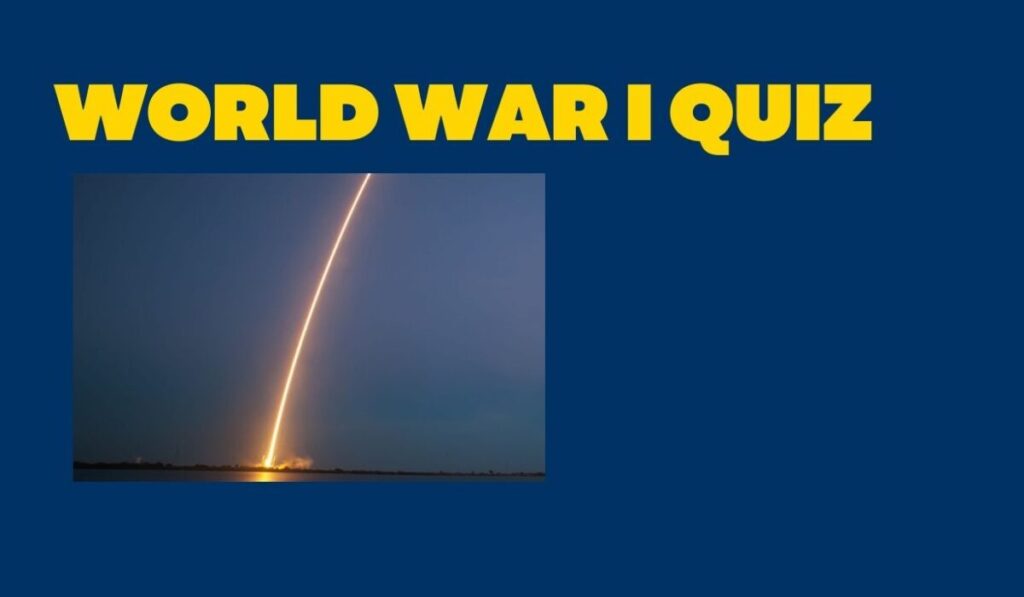World War 1 Quiz Questions and Answers:On June 28, 1914, a Yugoslav nationalist assassinated Archduke Franz Ferdinand, the prince of Austria and the heir to the throne of Austria-Hungary, sparking the First World War.
The imperialistic insurance policies of the good powers of Europe, including the German Empire, the Austro-Hungarian Empire, the Ottoman Empire, the Russian Empire, the British Empire, France, and Italy, were the long-term causes.
The belligerents included France, the British Empire, the Russian Empire, the United States, Italy, Japan, Belgium, and others, while the central powers included the German Empire, Austria-Hungary, the Ottoman Empire, and Bulgaria.
England declared war on Germany on August 4, 1914, and the conflict ended on November 11, 1918.
Many competitive examinations include GK questions from World Wars I and II. As a result, it is critical to prepare for this topic in order to do well on an exam’s general awareness component. We have 50 World War 1 Quiz Questions and answers here, and we will have World War II quiz questions in the future topic.
Here Lets start World War 1 Quiz Questions and Answers
- Which country made the first declaration of war?
- Germany
- Serbia
- Russia
- Austria-Hungary
- In what city was Archduke Franz Ferdinand assassinated?
- Zagreb
- Sarajevo
- Belgrade
- Vienna
- At the beginning of World War I, Bosnia-Herzegovina was part of
- Austria-Hungary
- Yugoslavia
- Serbia
- Croatia
- To which other prominent leader was Kaiser Wilhelm II of Germany related?
- Woodrow Wilson of the United States
- Franz Joseph of Austria-Hungary
- Nicholas II of Russia
- Winston Churchill of Britain
- Germany’s attack upon which country directly provoked Britain to go to war?
- France
- Russia
- Belgium
- Holland
- Germany’s plan for fighting France and Russia was called
- The Hindenburg Plan
- The Schlieffen Plan
- Operation Barbarossa
- Sturm und Drang
- What key fortress was the scene of the heaviest fighting during the German invasion of Belgium?
- Liege
- Fort Heineken
- The Hague
- Maginot
- Which Russian general lost the Battle of the Masurian Lakes?
- Samsonov
- Kornilov
- Kerensky
- Rennenkampf
- Which early battle marked the first major German defeat?
- Tannenberg
- The Marne
- Mons
- Masurian Lakes
- Which best describes Austria-Hungary’s progress early in the war?
- Defeat by Russia; defeat by Serbia
- Victory over Russia; defeat by Serbia
- Defeat by Russia; victory over Serbia
- Victory over Russia; victory over Serbia
- What event prompted the Ottoman Empire to enter the war?
- A British attack on the Dardanelles
- A German attack on Russia
- A Russian attack on Austria
- A British attack on Gallipoli
- The commander of the German East Asia Squadron was
- Otto von Bismarck
- Erich Ludendorff
- Alfred von Tirpitz
- Maximilian von Spee
- The Battle of the Falkland Islands resulted in
- Victory for Britain
- Victory for Argentina
- Victory for Germany
- Victory for Turkey
- Which is generally not true of sea warfare during World War I?
- Submarines and mines were a cheap and effective way to threaten battleships
- Convoys eventually proved to be the most effective defense against submarines
- The British navy dominated the world’s oceans through its aggressive use of submarine warfare
- Great sea battles between surface ships were relatively rare during the war
- Why did Britain need control of the Dardanelles?
- To open shipping routes with Russia
- To gain access to the Persian Gulf
- To cut off German naval bases in the Black Sea
- To prevent Russian ships from entering the Baltic Sea
- Which was a political result of Britain’s invasion of Gallipoli?
- Winston Churchill was elected prime minister
- The Royal Air Force was formally established
- Australia and New Zealand refused any further participation in the war
- A major shakeup in the leadership of the Royal Navy ensued
- What was the initial purpose of Britain’s invasion of Mesopotamia?
- To open shipping routes on the Tigris and Euphrates rivers
- To liberate Kuwait
- To seize oil fields along the Persian Gulf
- To capture Tehran
- Which best describes the outcome of Townshend’s campaign in Mesopotamia?
- Ten thousand British troops were surrendered after a failed march on Baghdad
- Townshend’s army took 100,000 Turkish prisoners of war in a single day
- The Ottoman Empire lost control of the entire region
- Constantinople was cut off from the Turkish mainland
- How is the western front in World War I best characterized?
- A stagnant war fought from trenches, with neither side gaining or losing much ground in spite of huge casualties
- One of the most dynamic front lines of the twentieth century
- The first war front in history dominated by air power
- A mostly inactive front, along which both sides took a primarily defensive stance, resulting in relatively few casualties
- Italy’s action in the war was primarily against
- Germany
- Greece
- Austria-Hungary
- France
- A war of attrition is defined as
- A war in which both sides periodically exchange prisoners and then continue fighting
- A war that is ended by a single crushing strike
- A war that is won by cutting off the enemy’s supply line
- A war in which victory is determined not by which side seizes the most territory but by which side loses the most men
- Which battle lasted for ten months, the longest of the war?
- Battle of the Somme
- Battle of Messines Ridge
- Battle of Verdun
- Battle of Passchendaele
Which country joined the war on the side of the Allied Powers in 1916?
- Bulgaria
- Greece
- Serbia
- Romania
- What major change in German policy contributed to the United States entering the war?
- An end to diplomatic relations with the United States
- The declaration of unrestricted submarine warfare
- Economic sanctions against the United States
- An anti-British propaganda campaign in the American media, paid for by the German embassy
- The Zimmermann telegram urged which country to attack the United States?
- Mexico
- Cuba
- Panama
- Canada
- What country first intercepted the Zimmermann telegram?
- The United States
- Canada
- France
- Great Britain
- What was the name of the first U.S. civilian ship to be sunk by a German submarine?
- Lusitania
- Housatonic
- Titanic
- Maine
- On what date did the United States declare war on Germany?
- December 7, 1914
- April 6, 1917
- January 29, 1918
- November 4, 1917
- Who was the commander of U.S. forces in Europe?
- Eddie Rickenbacker
- Dwight D. Eisenhower
- Theodore Roosevelt
- John J. Pershing
- Following the declaration of war, U.S. forces
- Immediately attacked Germany
- Mobilized and deployed to Europe but did not enter combat for many months
- Concentrated on defending the U.S. mainland
- Went on alert but did not mobilize
What did Germany do in 1917 to hasten Russia’s exit from the war?
- Hired mercenaries to assassinate the tsar
- Bombed food warehouses in major Russian cities
- Helped Russian revolutionaries in exile to get back to Russia
- Revealed that the tsar’s German-born wife was spying for the kaiser
- Which of the following best describes Lenin’s role in the February Revolution?
- He was not involved
- As a member of the Duma, he put pressure on the tsar to abdicate
- He supplied arms to the demonstrators
- He planned the revolt
Who ordered the Russian offensive on July 1, 1917?
- Tsar Nicholas II
- Vladimir Lenin
- Alexander Kerensky
- Leon Trotsky
- What was Lenin’s first decree after the Bolshevik Revolution?
- An order that the Russian army surrender to Germany
- A request to the Central Powers to begin armistice negotiations
- A proclamation that Germany must be defeated at all costs
- A declaration of peace
- Which best describes the outcome of Russia’s peace negotiations?
- Russia gained territory
- Russia lost territory
- Russia neither gained nor lost territory
- Russian soldiers would have to serve in the German army on the western front
- How did Russia’s withdrawal affect the Allied forces?
- Allied troops were soon to be outnumbered by the Germans
- With Russia out of the picture, peace negotiations would become easier
- Without Russian help, Serbia fell to Austria-Hungary
- France withdrew from Alsace-Lorraine
In 1918, the city of Paris suffered repeated attacks from German
- Tanks
- Bombers
- Long-range artillery
- Poison gas shells
- After declaring war, the United States was
- Officially part of the Central Powers
- At war only with Germany, not with Austria-Hungary
- Officially part of the Allied forces
- At war only with Austria-Hungary, not with Germany
- Which of the following was a point of contention between the United States and the French and British?
- U.S. commanders refused to allow American troops to serve in French or British regiments
- The U.S. did not send any troops to Europe
- There were many unpleasant incidents between U.S. soldiers and local civilians
- S. commanders refused to coordinate their actions with Allied commanders
- What pandemic disease threatened soldiers and civilians on all sides during the late stages of the war?
- Dysentery
- Measles
- Influenza
- Cholera
- Which battle was the first major victory for American troops?
- Cantigny
- Lys
- Moreuil Wood
- Passchendaele
- What country was the first of the Central Powers to surrender?
- Italy
- Austria-Hungary
- Greece
- Bulgaria
- Who assumed power in Germany and led negotiations with the Allies after Wilhelm II lost power?
- Max von Baden
- Paul von Hindenburg
- Otto von Bismarck
- Manfred von Richthofen
- Over which border region did fighting break out between Poland and Ukraine at the end of the war?
- Sudetenland
- East Galicia
- Transylvania
- Belorussia
- Which new country was created as a “south Slavic state”?
- Czechoslovakia
- Bosnia-Herzegovina
- Montenegro
- Yugoslavia
- What immediate condition was required of the Ottoman Empire in order to make peace?
- Constantinople had to be given back to Greece
- All troops had to be withdrawn from Gallipoli
- Free shipping had be reopened through the Dardanelles
- The ships Goebenand Breslau had to be returned to Germany
- Where was the initial armistice with Germany negotiated?
- In the Reichstag building in Berlin
- In a train car near Compiègne, France
- At the Vatican
- At Versailles, France
- Austria-Hungary made its armistice
- Jointly with Germany
- After negotiations with Russia held in Yalta
- After negotiations held in Italy
- At a formal ceremony at the White House
- Which is true of Kaiser Wilhelm II?
- He abdicated voluntarily following a mutiny in the German navy
- Prince Max von Baden announced the kaiser’s abdication without his consent
- He committed suicide
- He personally signed the armistice agreement
- The formal peace treaty with Germany
- Was signed under the Arc de Triomphe in Paris
- Was signed on a ship sailing in neutral waters
- Stipulated that Germany must give up its entire northern coastline
- Was signed at Versailles

